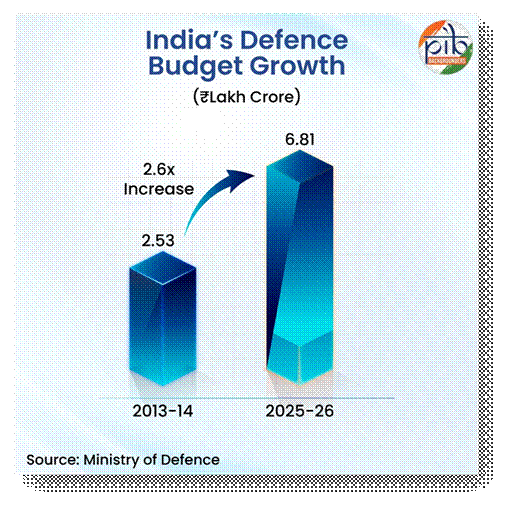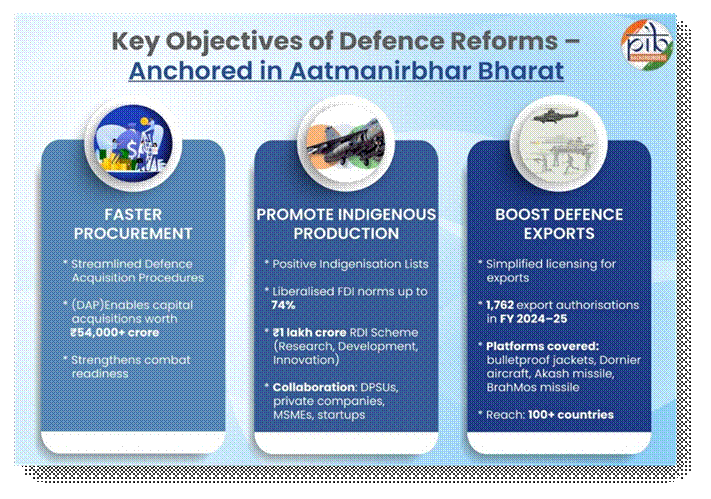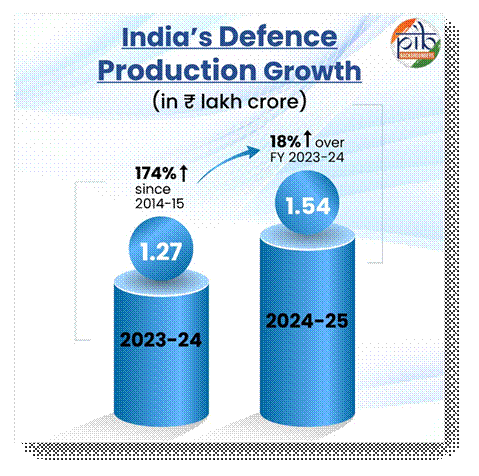PIB Headquarters
Defence Atmanirbharta: Record Production and Exports
Posted On:
20 NOV 2025 10:29AM by PIB Delhi
- India recorded its highest-ever defence production of ₹1.54 lakh crore in FY 2024 25
- Indigenous defence production hit a record ₹1,27,434 crore in FY 2023-24, a 174% surge from ₹46,429 crore in 2014-15
- 16,000 MSMEs are emerging as the game-changers, strengthening indigenous defence capabilities
- 788 industrial licenses have been issued to 462 companies.
- India s defence exports reached a record ₹23,622 crore in FY 2024 25 from less than ₹1,000 crore in 2014.

India's indigenous defence production hit a record ₹1,27,434 crore in FY 2023-24, a 174% surge from ₹46,429 crore in 2014-15, fueled by Prime Minister Shri Narendra Modi's Atmanirbharta policies. The upward trajectory in defence production is the result of continued government support over the past decade in the form of huge allocation and policy level support extended to India s military industrial base. The rise in the defence budget, from ₹2.53 lakh crore in 2013-14 to ₹6.81 lakh crore in 2025-26, underlines the government s determination to strengthen country s military infrastructure. In order to reduce dependency on foreign countries, both public and private segments of the industry have demonstrated consistent year-on-year growth, attributed to far-reaching policy reforms, enhanced ease of doing business, and a strategic focus on indigenisation over the past decade. India now exports to over 100 nations, including to United States, France and Armenia. Defence Public Sector Undertakings (DPSUs) and other PSUs accounted for approx. 77% of total production, while the private sector contributed 23%. The share of the private sector, which increased from 21% in FY 2023-24 to 23% in FY 2024-25, reflects the sector's growing role in the defence ecosystem of the country. As a result, exports too saw a growth of Rs 2,539 crore or 12.04% over the exports figures of FY 2023-24. The government aims to achieve defence manufacturing worth Rs. 3 lakh crore and ₹50,000 crore in defence exports by 2029, reinforcing India's role as a global defence manufacturing hub while boosting economic growth. Therefore, India's defence production sector is poised for continued acceleration in the years ahead, making the country Atmanirbhar.
Challenges Before Policy Reforms
Prior to the policy reforms initiated under the government of Prime Minister Shri Narendra Modi during the last decade, India s defence sector faced significant bottlenecks. Procurement processes were slow, resulting in critical capability gaps. Dependence on imports was high, straining foreign exchange reserves and exposing vulnerabilities during global disruptions. Earlier, private sector participation was limited due to restrictive policies, dominance of defence PSUs, and lack of technology access. Defence exports were not that high, valued at only ₹686 crore in FY 2013 14, positioning India primarily as an importer rather than a producer in the global defence market. To meet these challenges, the Ministry of Defence s draft Defence Production & Export Promotion Policy (DPEPP) sets the compass for making India a top global defence manufacturer by encouraging R&D, rewarding innovation and IP creation, promoting industry-academia linkages, supporting MSMEs and setting export ambitions. The policy stitches together production, technology, and market access into one roadmap.
Objectives of Reforms
Anchored in the vision of Aatmanirbhar Bharat, the Government launched a series of reforms to build a self-reliant, globally competitive defence industry. The key objectives include:
Faster procurement through streamlined Defence Acquisition Procedures (DAP), followed by DAC (Defence Acquisition Council), giving nod for acquisitions.
Promoting indigenous production via Positive Indigenisation Lists, liberalised FDI norms for automatic route up to 74% and up to 100% through the government route, and the ₹1 lakh crore Research, Development and Innovation (RDI) Scheme, fostering collaboration among DPSUs, private companies, MSMEs, and startups.

Boosting defence exports with simplified licensing, covering platforms such as bulletproof jackets, Dornier aircraft, Chetak Helicopters, and fast interceptor boats, and lightweight torpedoes.
Declared as the Year of Reforms in 2025, the initiatives aim to transform the Armed Forces into a technologically advanced, combat-ready force capable of multi-domain integrated operations, while expanding defence production to ₹3 lakh crore and achieving export targets of ₹50,000 crore by 2029.
Defence Acquisition Procedure (DAP) Reforms
Anchored in the vision of Aatmanirbhar Bharat, the Government of India has undertaken a series of landmark reforms to transform the defence procurement ecosystem. The twin frameworks, the Defence Acquisition Procedure (DAP) 2020 and the Defence Procurement Manual (DPM) 2025, together form the backbone of this transformation, ensuring speed, transparency, innovation, and self-reliance across both capital and revenue procurements.
DAP 2020: The Strategic Roadmap for Self-Reliant Acquisition

The Defence Acquisition Procedure (DAP) 2020 represents a transformative policy framework that serves as both a rulebook and a strategic roadmap for modernising the acquisition process while fostering a globally competitive domestic defence industry. Designed to overcome legacy challenges such as delays and import dependence, it embeds clarity, and indigenous innovation into every stage of acquisition.
Key features that redefine acquisition include:
- Indian First Approach: The policy gives top priority to the Buy {Indian-IDDM (Indigenously Designed, Developed and Manufactured)} category, promoting systems designed, developed, and manufactured indigenously, thereby making the country self-reliant.
- Speed with Transparency: Simplified approval processes and digital integration have accelerated procurement timelines while enhancing accountability.
- Technology of Tomorrow: The DAP 2020 includes dedicated provisions for acquiring cutting-edge technologies like AI, robotics, cyber, space, and advanced warfare system to enable multi-domain operations.
- Industry as Partner: It promotes a collaborative ecosystem involving private sector companies, start-ups, and MSMEs through initiatives such as Innovations for Defence Excellence (iDEX) and relaxed licensing norms.
- Ease of Approvals: Procedural bottlenecks have been removed through streamlined frameworks and empowered acquisition wings, ensuring timely decision-making.
DPM 2025: Streamlining Revenue Procurement
Building upon the DAP framework, the Defence Procurement Manual (DPM) 2025 was launched by Raksha Mantri Shri Rajnath Singh on October 2025, representing a major leap towards simplifying the procedures, bring uniformity in functioning. It will be helpful in providing goods and services required by the Armed Forces for operational preparedness, worth approximately ₹1 lakh crore. Effective, 1 November 2025, DPM 2025 introduces industry-friendly reforms aimed at ensuring fairness, transparency, accountability in procurement and participation from domestic enterprises.
Key highlights include: Ease of Doing Business, which entails standardized procedures across all Armed Forces and MoD organizations to reduce delays; Support for Innovation and Indigenisation, fostering collaboration with industry and academia; Industry-friendly provisions, such as lower liquidated damages (0.1% per week for indigenisation projects), guaranteed orders for indigenous products for up to five years, and the removal of the outdated No Objection Certificate from erstwhile Ordnance Factory Board; and Digital Integration and Transparency, which have led to improved e-procurement systems and data-driven monitoring, ensuring accountability and efficiency in procurement processes.
An Integrated Procurement Framework for the Future
Together, DAP 2020 and DPM 2025 represent a unified, forward-looking procurement architecture that aligns India s defence acquisition process with the twin goals of operational readiness and industrial self-reliance. The integration of capital and revenue procurement ensures faster delivery of critical systems to the Armed Forces while empowering Indian industry to scale up innovation, manufacturing, and exports.
This comprehensive procurement ecosystem marks a decisive shift towards making India a global hub for defence production and innovation, driving the realisation of Aatmanirbhar Bharat in the strategic domain.
Boosting Domestic Defence Production
1. From Dependence to Dominance:
The country recorded its highest-ever defence production of ₹1.54 lakh crore in FY 2024-25, a testament to the strength of Aatmanirbhar Bharat in action. India is on track to achieve a target of ₹1.75 lakh crore in defence production in the current fiscal year, while it aims to reach ₹3 lakh crore in defence production by 2029, further establishing itself as a global defence manufacturing hub.

2. Defence Industrial Corridors - The New Growth Arteries:
Two corridors, Uttar Pradesh Defence Industrial Corridor (UPDIC) and Tamil Nadu Defence Industrial Corridor (TNDIC), are the lifelines of this transformation. Together, they have attracted investments worth over ₹9,145 crore, with 289 MoUs signed, unlocking ₹66,423 crore in potential opportunities, as of October 2025.
3. Expanding the Defence Ecosystem:
DRDO has become a frontline institution that is driving India s defence revolution. Raksha Mantri Shri Rajnath Singh grant has approved a Corpus of Rs 500 crore to cater for deep-tech and cutting-edge projects as separate verticals under Technology Development Fund (TDF) scheme, Technology Transfers, and 15 Defence Industry-Academia Centres of Excellence (DIA-CoEs), it is directly linking academia, start-ups, and industries in defence innovation. The restructuring of Ordnance Factories and creation of seven defence companies, was undertaken to enhance functional autonomy, improve efficiency, and increase self-reliance in the defence preparedness of the country. The private sector is no longer a silent observer. From drones to avionics to cutting-edge electronics, companies both big and small are stepping up, while 16,000 MSMEs are emerging as the game-changers, proving that India s defence manufacturing is no longer just about the giants, it s an ecosystem where every innovator has a role to play.
4. Opening New Horizons - Investment Opportunities:
India has emerged as one of the most attractive destinations for defence investment. With 788 industrial licenses issued to 462 companies, the participation of Indian industry in defence manufacturing is growing rapidly. The Department of Defence Production has streamlined business through a fully digital portal for export authorizations, leading to 1,762 approvals in FY 2024 25, compared to 1,507 in FY 2023-24, marking a 16.92% year-on-year growth and a 17.4% increase in the number of exporters. Combined with liberalized FDI norms, the PLI scheme, and modern defence corridors, India offers a compelling opportunity for both domestic innovators and global investors.
In 2024-25, the Ministry of Defence signed a record 193 contracts valued at ₹2,09,050 crore, marking the highest ever in a single financial year. Of these, 177 contracts, worth ₹1,68,922 crore, were awarded to the domestic industry, reflecting a decisive shift toward Indian manufacturers and a strengthened indigenous defence ecosystem. This emphasis on local procurement has also spurred employment generation and technological innovation across the sector.
Defence Acquisitions: Accelerating Self-Reliance

India s defence acquisition landscape has seen transformative growth under the Aatmanirbhar Bharat initiative, with record budgetary allocations, streamlined procedures, and a renewed focus on indigenisation across the Services. At least 65% of defence equipment is now manufactured domestically, a significant shift from the earlier 65-70% import dependency, showcasing India's self-reliance in defence. India s approach ensures that every procurement strengthens national industry, reduces import dependency, and enhances operational preparedness.
Rising Acquisition Budget and Decadal Growth
The Defence Acquisition Council (DAC), chaired by the Raksha Mantri, has approved record volumes of indigenous procurements in recent years. Modernisation and indigenization of the Armed Forces remain a key priority of the Government. In the Union Budget 2024-25, an allocation of ₹1.72 lakh crore has been made under the Capital Head for the Defence Services, reflecting a 20.33% increase over the actual expenditure of FY 2022-23 and a 9.40% compared to the Revised Estimates of FY 2023-24.
In March 2025, the DAC approved eight capital acquisition proposals worth over ₹54,000 crore, including the 1,350 HP engines for T-90 tanks and indigenously developed Varunastra torpedoes and Airborne Early Warning & Control (AEW&C) systems.
In July 2025, the DAC cleared 10 capital acquisition proposals valued at approximately ₹1.05 lakh crore including Armoured Recovery Vehicles, Electronic Warfare System, Integrated Common Inventory Management System for the Tri-Services, Surface-to-Air Missiles, Moored Mines, Mine Counter Measure Vessels, Super Rapid Gun Mount, and Submersible Autonomous Vessels. All items approved are indigenous under the Buy (Indian-IDDM) category, emphasizing indigenously designed, developed, and manufactured systems.
In August 2025, the DAC approved proposals worth ₹67,000 crore to enhance the operational capabilities of the Armed Forces. Key approvals included Thermal Imager-based Night Sights for BMPs for the Army, Compact Autonomous Surface Craft, BrahMos Fire Control Systems, and BARAK-1 upgrades for the Navy, and Mountain Radars along with SAKSHAM/SPYDER upgrades for the Air Force. The DAC also cleared indigenous Medium Altitude Long Endurance (MALE) RPAs for all three Services, and maintenance support for C-17, C-130J, and S-400 systems.
Continuing the momentum, in October 2025, the DAC approved procurement proposals worth approximately ₹79,000 crore for the Army, Navy, and Air Force, reinforcing the Government s sustained commitment to capability enhancement and self-reliance across all domains of national defence. A key indigenous highlight being the Advanced Light Weight Torpedoes (ALWT) developed by DRDO's Naval Science & Technological Laboratory for the Navy. The other approvals include the Nag Missile System (Tracked) Mk-II (NAMIS), Ground Based Mobile ELINT System (GBMES), and High Mobility Vehicles (HMVs) for the Army; Landing Platform Docks, and 30mm Naval Surface Guns for the Navy; and the Collaborative Long Range Target Saturation/Destruction System for the Air Force.
Defence Export Promotion: India s Rising Profile

A New Export Story: Numbers That Speak
What was once a trickle is now a steady stream: India s defence exports reached a record ₹23,622 crore in FY 2024 25 registering a 12.04% growth over FY 2023 24 s ₹21,083 crore. Private sector exports contributed ₹15,233 crore, while DPSUs accounted for ₹8,389 crore, whereas the corresponding figures for FY 2023-24 were Rs 15,209 crore and Rs 5,874 crore respectively. In a major boost to defence exports, India has supplied a wide spectrum of products - including ammunition, arms, sub-systems, complete systems, and critical components - to around 80 countries during the 2024-25, reaffirming its role as a reliable partner in the global defence supply chain. The Defence Public Sector Undertakings (DPSUs) have shown a significant increase of 42.85% in their exports in the FY 2024-25 reflecting the growing acceptability of Indian products in the global market and the ability of the Indian defence industry to be
a part of the global supply chain.
Faster, Simpler, Digital Policies that Open Doors
The Government has actively simplified the export pathway, standard operating procedures for the export of Munitions List items have been rationalised, and a fully end-to-end online portal now processes export authorisations digitally, cutting time and paperwork for exporters. Open General Export Licences (OGEL) and a digital authorisation system have further eased routine exports.
Defence Exports as Diplomacy
Exports are more than commerce: they build trust, interoperability and long-term partnerships. India s expanding export basket, supplied to friendly countries, is an instrument of outreach, seen in defence cooperation, logistics support, training and spares packages that accompany sales. The widening list of importers signals growing global confidence in Indian platforms.
Successful Indigenous Platforms & the Export Basket
India s exports today are broad and practical, from bulletproof jackets, patrol boats and helicopters, to radars and lightweight torpedoes, showcasing the depth and diversity of India s defence manufacturing. While combat aircraft programmes like Tejas continue on the path to operational maturity and export discussions, India s current strength lies in a wide range of proven, operational systems and components.
India s strategic collaborations and bold policy initiatives are not just reforms; they represent the foundation of a new era in defence self-reliance and technological sovereignty. With domestic production and exports poised for remarkable growth, and cutting-edge technologies steadily integrating into the industrial ecosystem, the vision of India as a global defence manufacturing hub is no longer a distant aspiration, it is unfolding before us.
India has achieved the highest-ever growth in indigenous defence production in value terms, reflecting the success of government initiatives such as the Atmanirbhar Bharat Abhiyan, positive indigenisation lists, and strategic partnerships with the private sector. The emphasis on Make in India and the creation of a robust R&D and start-up ecosystem have further accelerated this transformation.
From the establishment of Defence Industrial Corridors to the expansion of export facilitation, every measure underscore India s commitment to reducing import dependency and promoting indigenous capabilities. Together, these efforts are shaping a resilient, technology-driven defence ecosystem that not only strengthens national security but also positions India as a trusted global partner in defence manufacturing and innovation.
References:
PIB:
https://www.pib.gov.in/PressReleasePage.aspx?PRID=2116612
https://www.pib.gov.in/PressReleasePage.aspx?PRID=2117348
https://www.pib.gov.in/Pressreleaseshare.aspx?PRID=1809577
https://www.pib.gov.in/PressNoteDetails.aspx?NoteId=154617&ModuleId=3
https://www.pib.gov.in/PressReleasePage.aspx?PRID=2154551
https://www.pib.gov.in/PressReleasePage.aspx?PRID=2098431
https://www.pib.gov.in/PressReleasePage.aspx?PRID=2148335
https://www.pib.gov.in/PressReleaseIframePage.aspx?PRID=2114546
https://www.pib.gov.in/PressReleaseIframePage.aspx?PRID=1764148
https://www.pib.gov.in/PressReleaseIframePage.aspx?PRID=2086347
https://www.pib.gov.in/PressReleasePage.aspx?PRID=2181894
https://www.pib.gov.in/PressReleasePage.aspx?PRID=1795537
https://www.pib.gov.in/Pressreleaseshare.aspx?PRID=1795540
https://www.pib.gov.in/PressReleasePage.aspx?PRID=1819937
https://www.pib.gov.in/Pressreleaseshare.aspx?PRID=1848671
https://www.pib.gov.in/PressReleasePage.aspx?PRID=2113268
https://www.pib.gov.in/PressReleasePage.aspx?PRID=2141130
https://www.pib.gov.in/PressReleaseIframePage.aspx?PRID=2089184
https://www.pib.gov.in/FactsheetDetails.aspx?Id=149238
https://static.pib.gov.in/WriteReadData/specificdocs/documents/2025/mar/doc2025324525601.pdf
https://static.pib.gov.in/WriteReadData/specificdocs/documents/2025/apr/doc202543531401.pdf
DD News:
https://ddnews.gov.in/en/rajnath-singh-clears-defence-procurement-manual-2025-to-speed-up-revenue-procurement-boost-aatmanirbharta/
https://ddnews.gov.in/en/defence-minister-rajnath-singh-launches-defence-procurement-manual-2025-to-boost-operational-readiness/
https://ddnews.gov.in/en/modernising-armed-forces-defence-ministry-declares-2025-as-year-of-reforms/
Ministry of Defence (MoD)
https://mod.gov.in/sites/default/files/DPM-2025%20VOLUME-I.pdf
DRDO
https://drdo.gov.in/drdo/en/offerings/schemes-and-services/dia-coes/Academia
Download in PDF
***
RK
(Release ID: 2191937)
Visitor Counter : 530